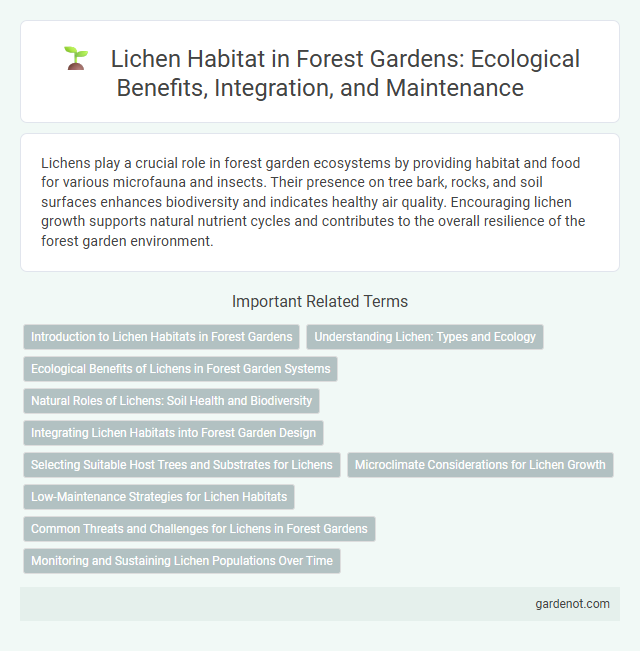Lichens play a crucial role in forest garden ecosystems by providing habitat and food for various microfauna and insects. Their presence on tree bark, rocks, and soil surfaces enhances biodiversity and indicates healthy air quality. Encouraging lichen growth supports natural nutrient cycles and contributes to the overall resilience of the forest garden environment.
Introduction to Lichen Habitats in Forest Gardens
Lichens in forest gardens thrive on diverse substrates including tree bark, fallen logs, and shaded soil surfaces, providing crucial ecological functions such as nutrient cycling and habitat for microfauna. Their presence indicates clean air quality and contributes to moisture retention within the microclimate of the garden ecosystem. Understanding lichen habitats aids in fostering biodiversity and improving forest garden resilience through natural symbiotic relationships.
Understanding Lichen: Types and Ecology
Lichens, a symbiotic association between fungi and algae or cyanobacteria, thrive in diverse forest garden habitats, serving as vital bioindicators of air quality and ecosystem health. They exist in multiple types, including crustose, foliose, and fruticose, each adapted to specific microclimates and substrate conditions found on tree bark, rocks, and soil. Lichens contribute to nutrient cycling, moisture retention, and provide food and shelter for various invertebrates, enhancing biodiversity within forest gardens.
Ecological Benefits of Lichens in Forest Garden Systems
Lichens in forest garden systems enhance biodiversity by creating microhabitats for insects and microorganisms, supporting ecosystem stability. They contribute to nutrient cycling through nitrogen fixation, enriching soil fertility critical for plant growth. Their presence indicates air quality and moisture levels, serving as natural environmental bioindicators in diverse forest gardens.
Natural Roles of Lichens: Soil Health and Biodiversity
Lichens play a critical role in forest garden ecosystems by contributing to soil health through nitrogen fixation and organic matter accumulation. Their symbiotic relationship between fungi and algae supports nutrient cycling, enhancing soil fertility and promoting microbial diversity. This natural process fosters a rich habitat for various microorganisms and insects, boosting overall biodiversity within the forest garden.
Integrating Lichen Habitats into Forest Garden Design
Integrating lichen habitats into forest garden design enhances biodiversity by providing essential microhabitats on tree bark and shaded surfaces. Selecting native tree species with rough bark encourages lichen colonization, supporting air quality monitoring and nutrient cycling. Maintaining appropriate humidity and reducing air pollution within the garden fosters optimal lichen growth and ecosystem resilience.
Selecting Suitable Host Trees and Substrates for Lichens
Selecting suitable host trees and substrates is critical for promoting healthy lichen habitats in forest gardens. Lichens thrive on trees with stable, rough bark such as oaks, maples, and pines, which provide optimal moisture retention and surface area for colonization. Incorporating diverse tree species and avoiding excessive bark damage enhances lichen diversity, supporting ecosystem resilience and air quality improvement.
Microclimate Considerations for Lichen Growth
Lichen growth in forest gardens thrives under stable microclimate conditions characterized by consistent humidity, moderate temperatures, and filtered sunlight, which are essential for their symbiotic relationship between algae and fungi. The presence of shade from canopy layers helps maintain moisture levels and reduces desiccation stress, promoting diverse lichen communities. Ensuring minimal air pollution and low nutrient deposition further supports optimal lichen habitat within forest garden ecosystems.
Low-Maintenance Strategies for Lichen Habitats
Lichen habitats in forest gardens thrive through low-maintenance strategies that emphasize natural substrate preservation and minimal disturbance. Retaining dead wood, rocks, and old tree bark creates ideal conditions for lichen colonization and biodiversity support. Implementing shaded microclimates and avoiding chemical use enhances lichen growth, promoting a sustainable, low-input ecosystem.
Common Threats and Challenges for Lichens in Forest Gardens
Common threats to lichens in forest gardens include air pollution, habitat destruction, and climate change, which disrupt their sensitive symbiotic relationships. Excessive tree trimming and the removal of deadwood reduce available substrates for lichen colonization, limiting their growth and biodiversity. Invasive species and altered microclimates further challenge lichen survival, impacting the overall ecological balance of forest gardens.
Monitoring and Sustaining Lichen Populations Over Time
Monitoring lichen populations in forest gardens involves regular assessment of species diversity, coverage, and physiological health to detect environmental changes and stressors. Utilizing standardized sampling methods and photographic documentation helps track lichen growth patterns and their response to microclimatic factors over time. Sustaining these populations requires minimal disturbance, maintaining appropriate humidity levels, and preserving substrate quality to support ongoing lichen colonization and biodiversity.
Lichen habitat Infographic

 gardenot.com
gardenot.com